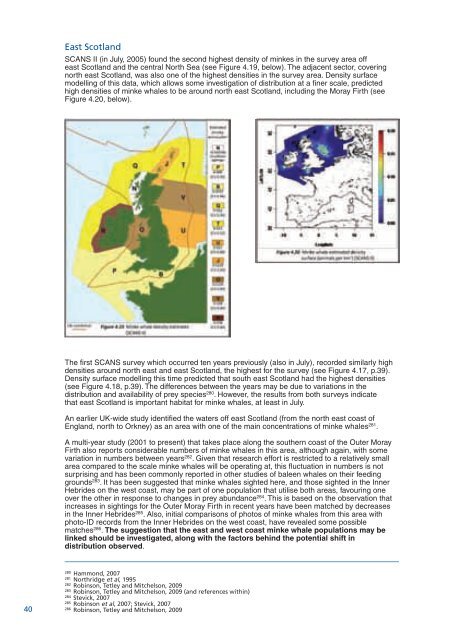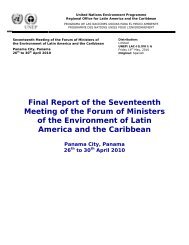East ScotlandSCANS II (in July, 2005) found the second highest density of minkes in the survey area offeast Scotland and the central North Sea (see Figure 4.19, below). The adjacent sector, coveringnorth east Scotland, was also one of the highest densities in the survey area. Density surfacemodelling of this data, which allows some investigation of distribution at a finer scale, predictedhigh densities of minke whales to be around north east Scotland, including the Moray Firth (seeFigure 4.20, below).The first SCANS survey which occurred ten years previously (also in July), recorded similarly highdensities around north east and east Scotland, the highest for the survey (see Figure 4.17, p.39).Density surface modelling this time predicted that south east Scotland had the highest densities(see Figure 4.18, p.39). The differences between the years may be due to variations in thedistribution and availability of prey species 280 . However, the results from both surveys indicatethat east Scotland is important habitat for minke whales, at least in July.An earlier UK-wide study identified the waters off east Scotland (from the north east coast ofEngland, north to Orkney) as an area with one of the main concentrations of minke whales 281 .A multi-year study (2001 to present) that takes place along the southern coast of the Outer MorayFirth also reports considerable numbers of minke whales in this area, although again, with somevariation in numbers between years 282 . Given that research effort is restricted to a relatively smallarea compared to the scale minke whales will be operating at, this fluctuation in numbers is notsurprising and has been commonly reported in other studies of baleen whales on their feedinggrounds 283 . It has been suggested that minke whales sighted here, and those sighted in the InnerHebrides on the west coast, may be part of one population that utilise both areas, favouring oneover the other in response to changes in prey abundance 284 . This is based on the observation thatincreases in sightings for the Outer Moray Firth in recent years have been matched by decreasesin the Inner Hebrides 285 . Also, initial comparisons of photos of minke whales from this area withphoto-ID records from the Inner Hebrides on the west coast, have revealed some possiblematches 286 . The suggestion that the east and west coast minke whale populations may belinked should be investigated, along with the factors behind the potential shift indistribution observed.40280Hammond, 2007281Northridge et al, 1995282Robinson, Tetley and Mitchelson, 2009283Robinson, Tetley and Mitchelson, 2009 (and references within)284Stevick, 2007285Robinson et al, 2007; Stevick, 2007286Robinson, Tetley and Mitchelson, 2009
Sightings for this area of the Outer Moray Firth are commonly recorded between June and October,with peaks during July and August, and a general inshore movement as the season progresses 287 .Overall, a preference has been noted for the central and eastern areas of the study site. This areais thought to provide rich coastal feeding habitat for minke whales during the summer period atleast 288 . Foraging minke whales are regularly recorded in this part of the Outer Moray Firth, oftenengaging in bird-associated feeding, where prey species are compacted at the surface by feedingseabirds above and predatory fish below 289 .Movements into and within the area are most likely connected to the accessibility and distributionof different prey species, and these in turn will be determined by physiographic and oceanographicvariables. In the absence of quantitative fisheries data for prey species 290 , these variables can bestudied as a proxy and indirectly linked to minke whale distribution. In the southern Outer MorayFirth, correlations have been found between minke whale distribution and static, physical characteristicsand also more fluid oceanographic variables. Minke whale distribution in this area was found to bestrongly correlated to sediment type, with a clear preference for sandy-gravel sediments 291 . Thissediment type is optimal sandeel habitat 292 which likely explains this correlation. Minke whaledistribution has also been correlated with warm water plume events that occur in the Moray Firthand at times dominate a cold water current (the Dooley current) that enters the area from thenorth 293 . These warm water events appear to result in increased phytoplankton densities which arethought to attract greater numbers of sandeels, and in turn result in greater numbers of minkes inthe area 294 .There are fewer data available for the rest of the Outer Moray Firth but recent surveys and a reviewof sightings for the area report that minke whales are commonly encountered throughout thearea 295 . They appear to be the second most commonly sighted species in offshore waters afterharbour porpoises, although this may be a relatively recent situation as it does not appear to havebeen the case a few years ago 296 .Sightings are fewer for the Inner Moray Firth but do occur throughout much of the year, albeit inlow numbers 297 .287Robinson et al, 2007; Reid et al, 2003 (monthly data); Robinson, Tetley and Mitchelson, 2009288Robinson and Tetley, 2007; Robinson et al, 2007289Robinson and Tetley, 2007290Robinson, Tetley and Mitchelson, 2009291Robinson, Tetley and Mitchelson, 2009292Ibid293Tetley et al, 2008294Ibid295Eisfeld et al, 2009; Thompson et al, 2010296Thompson et al, 2010297Bailey and Thompson, 200941
- Page 1 and 2: WDCS, the Whale and Dolphin Conserv
- Page 3 and 4: Towards Marine ProtectedAreas for C
- Page 5 and 6: South west EnglandCeltic Deep - com
- Page 7 and 8: CONTENTSExecutive Summary 2Acknowle
- Page 9 and 10: 1. INTRODUCTIONWe enter an exciting
- Page 11 and 12: Note: This schematic map shows thev
- Page 13 and 14: 2. IDENTIFYING MARINE PROTECTED ARE
- Page 15 and 16: 3. CRITICAL HABITATInterest in the
- Page 17 and 18: Foraging, travel, socialising and p
- Page 19 and 20: 4. DATA AND SPECIES ACCOUNTSIn orde
- Page 21 and 22: Killer whale (Orcinus orca)Atlantic
- Page 23 and 24: 4.4 SPECIES ACCOUNTS4.4.1 HARBOUR P
- Page 25 and 26: Although there is some variation in
- Page 27 and 28: North ScotlandThe first SCANS surve
- Page 29 and 30: East EnglandThe seasonal pattern in
- Page 31 and 32: Irish SeaOutside of coastal Welsh w
- Page 33 and 34: 4.4.2 BOTTLENOSE DOLPHIN (Tursiops
- Page 35 and 36: This expansion in range means this
- Page 37 and 38: 4.4.3 SHORTBEAKED COMMON DOLPHIN (D
- Page 39 and 40: South west EnglandBased on observat
- Page 41: 4.4.4 COMMON MINKE WHALE (Balaenopt
- Page 45 and 46: The JNCC Atlas of cetacean distribu
- Page 47 and 48: 4.4.5 WHITEBEAKED DOLPHIN (Lagenorh
- Page 49 and 50: 4.4.6 RISSO'S DOLPHIN (Grampus gris
- Page 51 and 52: 4.4.7 KILLER WHALE OR ORCA (Orcinus
- Page 53 and 54: 4.4.8 ATLANTIC WHITESIDED DOLPHIN (
- Page 55 and 56: 4.4.9 LONGFINNED PILOT WHALE (Globi
- Page 57 and 58: 4.4.10 SPERM WHALE (Physeter macroc
- Page 59 and 60: 4.4.11 BEAKED WHALESNORTHERN BOTTLE
- Page 61 and 62: which looked at worldwide beaked wh
- Page 63 and 64: There is no current population esti
- Page 65 and 66: 4.5 SCOTTISH MPA GUIDELINES - STAGE
- Page 67 and 68: Northern bottlenose whale and Sower
- Page 69 and 70: Fisheries BycatchFisheries bycatch
- Page 71 and 72: 5.2 AN OVERVIEW OF REGIONAL THREATS
- Page 73 and 74: North ScotlandAs in the west, threa
- Page 75 and 76: 6. IDENTIFYING CRITICAL HABITAT IN
- Page 77 and 78: 6.1.1 HARBOUR PORPOISEWest and sout
- Page 79 and 80: Assessment: Critical HabitatHigh re
- Page 81 and 82: 11. Area: Off Land's End, Cornwall
- Page 83 and 84: Threats, status and relative import
- Page 85 and 86: East Scotland3. Area: North east Sc
- Page 87 and 88: Threats, status and relative import
- Page 89 and 90: 6.1.4 COMMON MINKE WHALEWest and so
- Page 91 and 92: 6.1.5 WHITEBEAKED DOLPHINWest and s
- Page 93 and 94:
Coastal Wales2. Area: Bardsey Islan
- Page 95 and 96:
6.1.8 ATLANTIC WHITESIDED DOLPHINNo
- Page 97 and 98:
Other areasOne other area was asses
- Page 99 and 100:
6.1.11 BEAKED WHALESThe northern Ro
- Page 101 and 102:
7. PROTECTING CRITICAL HABITAT - RE
- Page 103 and 104:
considered in the area, each of whi
- Page 105 and 106:
7.4 EAST SCOTLANDWithin the east Sc
- Page 107 and 108:
7.5 SOUTH WEST ENGLANDWithin the so
- Page 109 and 110:
An SAC is already in place for bott
- Page 111 and 112:
7.9 SUMMARYFour areas of identified
- Page 113 and 114:
iv. Licensing processes for industr
- Page 115 and 116:
9. IDENTIFICATION AND PRIORITISATIO
- Page 117 and 118:
Recommendations on particular data
- Page 119 and 120:
Coastal Wales northern Pembrokeshir
- Page 121 and 122:
ANNEX II SPECIES ACCOUNTS SUMMARY
- Page 123 and 124:
HARBOUR PORPOISEEast ScotlandStudyH
- Page 125 and 126:
HARBOUR PORPOISESouth West EnglandS
- Page 127 and 128:
HARBOUR PORPOISECoastal WalesStudyT
- Page 129 and 130:
BOTTLENOSE DOLPHINStudyTemporalReso
- Page 131 and 132:
SHORTBEAKED COMMON DOLPHINStudyTemp
- Page 133 and 134:
SHORTBEAKED COMMON DOLPHINStudyTemp
- Page 135 and 136:
COMMON MINKE WHALEWest ScotlandStud
- Page 137 and 138:
WHITEBEAKED DOLPHINStudyTemporalRes
- Page 139 and 140:
KILLER WHALEStudyTemporalResolution
- Page 141 and 142:
ATLANTIC WHITESIDED DOLPHINStudyTem
- Page 143 and 144:
SPERM WHALEStudyTemporalResolutionS
- Page 145 and 146:
BALEEN WHALESStudyTemporalResolutio
- Page 147 and 148:
ANNEX III THREATS TO CETACEANS - RE
- Page 149 and 150:
Actual orPotential ThreatActivitySp
- Page 151:
North ScotlandSpecies of most relev
- Page 156 and 157:
East EnglandSpecies of most relevan
- Page 158 and 159:
South East EnglandSpecies of most r
- Page 160 and 161:
South West EnglandSpecies of most r
- Page 162 and 163:
Irish SeaSpecies of most relevance
- Page 164 and 165:
Actual orPotential ThreatActivitySp
- Page 166 and 167:
Bravington, M., Borchers, D. and No
- Page 168 and 169:
Evans, P.G.H. and Anderwald, P. 200
- Page 170 and 171:
ICES WGMME. 2006. Report of the Wor
- Page 172 and 173:
ECS/ASCOBANS/ACCOBAMS Workshop held
- Page 174 and 175:
marine protected areas effective to
- Page 176:
ISBN: 9781901386233
















